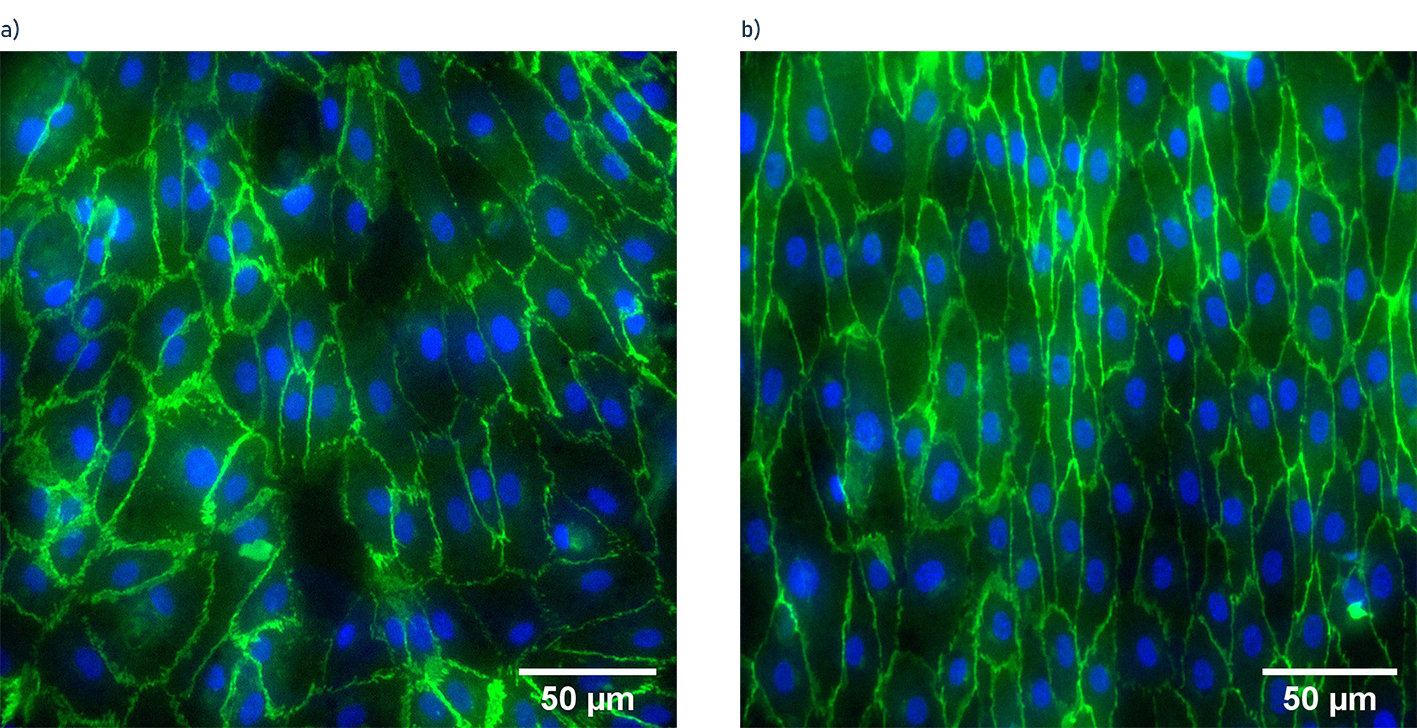Response of Senescent Endothelial Monolayers to Multiple Mechanical Stimuli
Blood vessels are lined by endothelial cells (ECs) which constantly interact with the luminal and abluminal extracellular environments [1]. Because of their particular location at the interface between blood stream and vascular walls, ECs are constantly exposed to a variety of stimuli.
Physical cues come from the underlying extracellular matrix (ECM) in the form of substrate topography and stiffness. Passive chemical cues come from the blood stream. Active mechanical stimuli arise as a consequence of blood flow pulsatility, like hemodynamic shear stress, pulsatile stretch and pressure [2]. These mechanical forces are a strong regulator of endothelial functions both in health and disease, therefore it is of fundamental importance to understand the mechanism by which ECs respond [3].

As ageing occurs, several changes take place in tissues and composes a considerable risk factor for chronic diseases [4]. Such changes are particularly apparent in human vasculature that presents the following features: decreased vascular density, thickened of the vessel, enlarged lumen, increased vascular stiffness, decreased angiogenesis, defective repair and pro-atherosclerotic response [5]. It has been shown that cellular senescence is strongly linked with the onset of endothelial dysfunctions and it is one of the main cause of cardiovascular diseases (CVDs) [6].
The aim of the research project is to develop systems able to faithfully reproduce the forces at play in the hemodynamic environment, delivering multiple mechanical stimuli simultaneously on ECs. Once the behaviour of healthy endothelial cells under these conditions have been established, in vitro model of senescence will be applied in order to assess the effect of cellular senescence on the response of endothelial monolayers.
Project Lead
Simone Tonnicchia
Funding
This work is supported by funding from the Swiss National Science Foundation under Grant SNF (205321_188828).
[1] Moncada, S. (2018). The Vascular Endothelium. In Endothelium and Cardiovascular Diseases: Vascular Biology and Clinical Syndromes (pp. 5–10). Elsevier. external page https://doi.org/10.1016/B978-0-12-812348-5.00001-5
[2] Dessalles, C. A., Leclech, C., Castagnino, A., & Barakat, A. I. (2021, December 1). Integration of substrate- and flow-derived stresses in endothelial cell mechanobiology. Communications Biology. Nature Research. external page https://doi.org/10.1038/s42003-021-02285-w
[3] Gordon, E., Schimmel, L., & Frye, M. (2020, June 18). The Importance of Mechanical Forces for in vitro Endothelial Cell Biology. Frontiers in Physiology. Frontiers Media S.A. external page https://doi.org/10.3389/fphys.2020.00684
[4] López-Otín, C., Blasco, M. A., Partridge, L., Serrano, M., & Kroemer, G. (2013, June 6). The hallmarks of aging. Cell. Elsevier B.V. external page https://doi.org/10.1016/j.cell.2013.05.039
[5] Tian, X. L., & Li, Y. (2014, September 20). Endothelial Cell Senescence and Age-Related Vascular Diseases. Journal of Genetics and Genomics. Institute of Genetics and Developmental Biology. external page https://doi.org/10.1016/j.jgg.2014.08.001
[6] Donato, A. J., Morgan, R. G., Walker, A. E., & Lesniewski, L. A. (2015, December 1). Cellular and molecular biology of aging endothelial cells. Journal of Molecular and Cellular Cardiology. Academic Press. external page https://doi.org/10.1016/j.yjmcc.2015.01.021